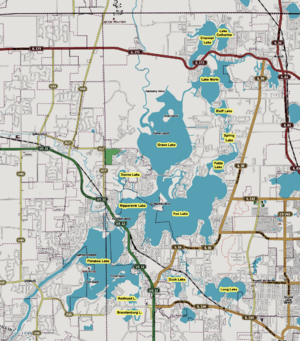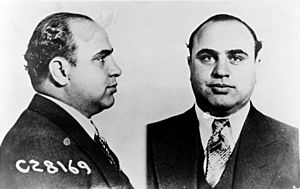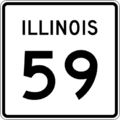Chain O'Lakes facts for kids
The Chain O'Lakes, often called "The Chain," is a cool system of 15 lakes in northeast Illinois. These lakes are all connected by the Fox River and some man-made channels. It's a huge area, with over 7,100 acres (about 28.7 square kilometers) of water and 488 miles (about 785 kilometers) of shoreline. This makes it one of the busiest places for water fun in the whole United States!
The Chain O'Lakes is located in Lake County and McHenry County. It's a super popular spot for outdoor recreation for people from Chicago and Milwaukee. On busy weekends, you might see 30,000 people, and on holidays, over 100,000 visitors come to enjoy the lakes! A special group called the Fox Waterway Agency helps manage and take care of the Chain O'Lakes.
Contents
What are the Chain O'Lakes?
The Chain O'Lakes has ten main lakes connected by the Fox River. Five other lakes are connected by smaller canals, but they are a bit harder to reach. Out of the ten main lakes, three are natural lakes: Grass Lake, Lake Marie, and Nippersink Lake. The other seven connected by the Fox River are Bluff Lake, Fox Lake, Pistakee Lake, Channel Lake, Petite Lake, Lake Catherine, and Redhead Lake. The five other lakes in the system are Duck Lake, Long Lake, Spring Lake, Dunns Lake, and Brandenburg Lake.
The Chain O'Lakes system starts near the border between Illinois and Wisconsin. The Fox River flows from the state border into Grass Lake, which is the first lake in the Chain. Grass Lake is the shallowest lake, usually only about 3 feet (1 meter) deep. But it's also the third largest, covering about 1,360 acres (about 5.5 square kilometers). Pistakee Lake and Fox Lake are the two biggest lakes, each about 1,700 acres (about 6.9 square kilometers). Grass Lake connects directly to Fox Lake, and both connect to Pistakee Lake through Nippersink Lake. The Fox River then leaves the Chain O'Lakes from the southwest part of Pistakee Lake.
How Big Are the Lakes?
Here's a look at the sizes of some of the lakes in the Chain O'Lakes system:
| Lake name | Area (acres) | Avg. depth (ft) |
|---|---|---|
| Catherine Lake | 155 | 45 |
| Channel Lake | 352 | - |
| Lake Marie | 480 | 14 |
| Bluff Lake | 86 | - |
| Petite Lake | 167 | 12 |
| Grass Lake | 1,360 | 3 |
| Fox Lake | 1,700 | - |
| Nippersink Lake | 420 | - |
| Pistakee Lake | 1,700 | - |
Grass Lake's Special History
In the late 1800s and early 1900s, Grass Lake was famous for its beautiful wild rice and lotus flowers. Over half of all the lotus flowers in the lakes grew right here! The water was so shallow and full of lotuses that sometimes boats had to be pushed with poles instead of rowed. Sadly, from the 1950s to the 1970s, many of the lotus flowers disappeared because of all the boats and people. But good news: they have started to grow back in recent years!
There's a famous spot on Grass Lake called Blarney Island. It started as a place where tourists came to see the lotus flowers. The story goes that two businessmen, Shorty Shobin and Jack O'Conner, who both ran boat tours, once played a game of poker. They bet their businesses, and Jack O'Conner won! He moved his business to the island, and over time, it became the well-known Blarney Island that it is today.
Towns Around the Chain
Many towns and cities are located around the Chain O'Lakes. Some of the main ones include Fox Lake, Lake Villa, Antioch, Spring Grove, Johnsburg, Volo, McHenry, and Ingleside. The town of Fox Lake is right in the middle of the system, between Pistakee Lake and Fox Lake.
History of the Chain O'Lakes
How the Lakes Were Formed
The Chain O'Lakes were formed a very long time ago when a giant sheet of ice, called the Wisconsin glacier, melted. As it melted, it left behind many lakes in the Fox River Valley, including all the lakes in the Chain.
The area was first home to different Native American tribes, like the Miami, Mascouten, and Potawatomi. The first European explorers, French trappers and traders like Joliet and Marquette, arrived in the mid-1600s.
In the 1800s, a few European families started to settle here. The Dunnill family and Converse Marble settled near Pistakee Lake and Nippersink Lake. Back then, the only way to get between these two lakes was through the winding Fox River. To make things easier, these families dug a new, shorter channel by hand. They called it "the Cut," which was a shortcut! This "Cut" created a strong current and brought fresh water to Nippersink Lake. Today, this channel is much deeper and wider, and many boats use it.
Until the 1880s, not many Europeans lived here because it was hard to travel through the wetlands around the Chain. But in the 1890s, the area became a popular vacation spot for people from Chicago. Many visitors came to take boat trips and see the beautiful "Egyptian Lotus" beds in Fox and Grass Lake.
The Early 1900s Boom
The Chain O'Lakes area really grew in the early 1900s when the Milwaukee Road railroad arrived in 1901. The railroad crossed the Chain where Pistakee Lake and Nippersink Lake are closest, which is now where US Route 12 crosses. A train station was built there, called Nippersink Point, and it became the center of the Fox Lake community.
The railroad made it easy for people from Chicago to visit, which led to a big increase in tourism. Many new resorts were built, joining older, famous ones like the Mineola.
Because so many people were visiting, the town of Fox Lake was officially created in 1907. At first, only a few hundred people lived there year-round, but in the summer, the population could jump to 20,000! The new town government had very few rules for its resorts, which helped the area continue to grow as a fun vacation spot.
From the Mid-1900s to Today
After the exciting 1920s, the Great Depression made things tough for the area. Many resorts closed, and the Chain O'Lakes wasn't as popular for tourists anymore. During this time, many summer cottages started to become permanent homes, especially after World War II when veterans returned.
After the war, the area became more modern and grew into a middle-class community. The trains that once brought vacationers now also help people who live here travel to work in Chicago and its nearby suburbs. By the year 2000, the population of Fox Lake had grown to over 9,000 people! Today, the Chain O'Lakes is a special mix of people who live there all year and those who come for summer vacations.
Fun Things to Do
The Chain O'Lakes is a fantastic place for all sorts of outdoor fun! You can go boating, kayaking, canoeing, hunting, fishing, birdwatching, swimming, water skiing, and tubing. There are also many local businesses, like marinas, restaurants, and bars, that serve visitors. Many of these places host special events all summer, like boat races, fishing tournaments, and live music. There's no limit on boat engine size on the Chain, and in 2009, there were over 28,000 registered boats!
You can also find great outdoor activities at Chain O'Lakes State Park and the nearby conservation area. This park was created in 1945 and has a free boat launch, plus areas for hunting, hiking, and fishing. Inside the park is Turner Lake, a small 44-acre (about 0.18 square kilometer) lake that's separate from the Chain. The park has four different walking trails, including one for people with disabilities and an 8-mile (about 13-kilometer) trail for horseback riding. Chain O'Lakes State Park also has campsites and cabins you can rent for a small fee. You can even rent horses and boats during the summer!
The Chain O'Lakes is a favorite spot for people who love to fish. You can find many kinds of fish here, like walleye, largemouth bass, muskellunge, yellow perch, bluegill, different types of catfish, black crappie, white bass, yellow bass, grass carp, and northern pike. The Illinois Department of Natural Resources says that about 10% of the muskellunge they check each year are over 3 feet, 6 inches (about 1.07 meters) long! Very large northern pikes and muskellunge are sometimes caught here. However, some invasive species have also been found in the Chain, like snakehead and zebra mussel.
When winter comes, the Chain O'Lakes still offers lots of fun! You can go snowmobiling, ice skating, cross-country skiing, and ice fishing.
Businesses on the Chain
The Chain O'Lakes is home to many businesses, including marinas, boat shops, resorts, campgrounds, restaurants, and bars. One of the most famous places is the Blarney Island bar on Grass Lake, which you can only reach by boat! The bar is built about a mile from shore on poles stuck into the shallow lake bottom.
Local stories say that Blarney Island started from a poker game between two rival businessmen, Jack O'Connor and Shorty Shobin, who both gave lotus bed tours. Jack won the game, and the business became his. Blarney Island started a boat shuttle service in 1972, began hosting live music in 1975, and started its famous boat races in 1978. It has grown a lot over the years and is now a very popular place to visit in the area.
Another well-known business from the past was the Mineola Resort. The Mineola Hotel was built in 1894 and had 100 rooms. It was the largest wooden building in Illinois and is now on the National Register of Historic Places. The resort was very popular in the 1920s.
Images for kids









